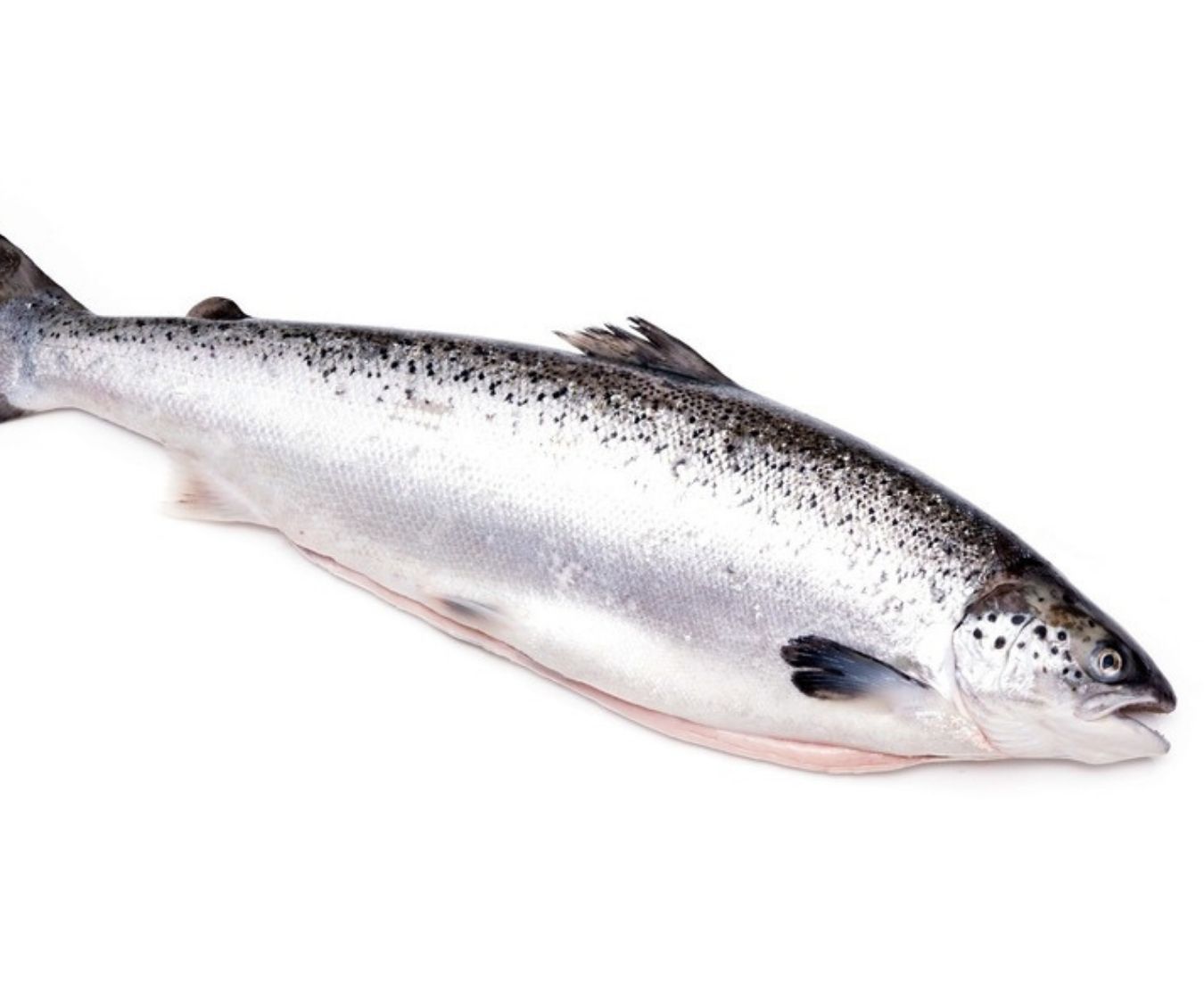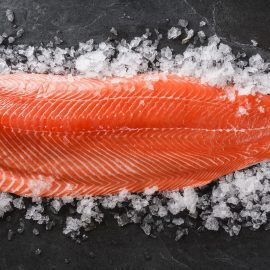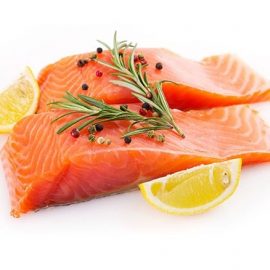
Introduction
Salmon are species of anadromous fish that are native to the Northern Atlantic, Pacific Ocean, and rivers all across the world. These fish have adapted their way of life and physiology to suit the coastal and freshwater environments they inhabit, providing an essential indication of the health of their ecosystems.
Description
Salmon, a migratory fish species, are highly valued for their economic and nutritional worth. Fishers worldwide typically harvest these fish through commercial contract salmon fishing, recreational angling, and traditional subsistence fishing by native communities.
This family of fish consists of various species, including Chinook (Oncorhynchus tshawytscha), sockeye (Oncorhynchus nerka), Atlantic (Salmo salar), and coho (Oncorhynchus kisutch). Salmon are anadromous fish, meaning they migrate between fresh and saltwater and back again and play a critical role in the lifecycles and diets of numerous species.
To ensure the sustainability of these species, careful management practices and regulations are necessary to balance the demand for these fish and conserve stocks.
Physical Characteristics
Salmon is a large and sleek fish native to the Pacific and Atlantic oceans and the rivers and streams of North America and Europe (genus Salmo). This species can be identified by a long and narrow body, an upturned beak at the mouth, and a distinctive black spot located behind each eye.
The colour of a Salmon can vary from silver on the top side and white on the belly to a more even silver-pink appearance. The visible exterior of the salmon also hides additional characteristics that distinguish the species from other fish. It has a single dorsal fin on the top of its body, a pair of pectoral fins on the sides, and a fatty fish fin (a small fat fin between the dorsal fin and the tail). A set of long thin barbels is also located near the head and mouth.
Male and female salmon can exhibit striking differences in size and appearance. Females are typically larger and have more bumps on their heads, while males usually have a hook-like snout known as a “kype”. Additionally, the colouration of male salmon is usually much brighter during the spawning season, while females tend to have duller colouring.
Salmon can range in size from 16 to 36 inches and weigh up to 20 pounds depending on the species.
Distribution and Habitat
Salmon spend most of their lives in aquatic habitats but come ashore during the breeding season to lay their eggs. Depending on the species, salmon may migrate to different parts of the world yearly to spawn, such as the Atlantic salmon to North America. On the other hand, the Pacific salmon migrate to Japan, Northwestern United States, and Canada. In addition, the chum salmon migrate to Chinook to spawn.
Salmon have an anadromous lifestyle, which means they spend much of their life in the ocean but migrate to freshwater streams and rivers to reproduce. The fins and scales of a salmon offer protection against predators, while the salmon’s keen sense of smell is used to detect food, mates, and predators. Salmon also have excellent hearing, so they can detect low-frequency sounds in the water.
These fish species can survive in diverse sub-arctic, cold, temperate, and warm climates. However, their ideal temperature range for spawning is between 5-10C. Salmon require a relatively clean and well-oxygenated habitat with adequate food and protection, and they usually prefer areas with higher salinities and slower currents.
Importance of Fisheries and Ecosystems
Salmon are vital to many fisheries and ecosystems as they provide valuable ecological services. As prey to numerous birds, mammals, and other fish, they form an essential part of their environment’s food chain.
The decomposition of salmon carcasses even enriches the habitats they inhabit and supplies essential nutrients back into their environment. In addition, salmon migrations are indicators of the local ecosystem’s health and are seen as keystone species in their respective ecosystems
Population and Conservation
Regrettably, some of the fishing activities, as well as incidental bycatch, have placed significant pressure on Salmon populations. This has led to wild salmon stocks declining in many areas and further compounded by the destruction of their spawning grounds through habitat degradation.
Due to Salmon’s ever-increasing importance, the species is the focus of many conservation, management, and fishing practices. Internationally, The North Pacific Anadromous Fish Commission (NPAFC) has taken responsibility for the maintenance and distribution of Salmon stocks, aiming to ensure their availability for both commercial and recreational fisheries. Non-profits and research groups have also joined the effort to ensure the future preservation of these fish and prevent further decline in their populations
Sustainable Fishing Practices
To ensure the sustainability of salmon populations, catch limits and quotas must be set, regulating the total annual harvest and protecting juveniles and adults of non-target species. These measures can include closed fishing seasons and fishing areas, rotational harvest, and catch and release techniques.
Other eco-friendly practices, such as using gear designed to capture only salmon and avoid bycatch, also help reduce the impacts of fishing on the marine environment. The latest technologies, such as acoustic tagging and satellite monitoring, are used to monitor and help manage salmon populations.
Salmon are heavily farmed in many places, especially Norway and Chile, and farm-raised salmon have become a staple food in the diets of countless people around the world. This commercial farming activity has allowed the species to be fished sustainably. Despite this, concerns have been raised regarding a number of environmental and animal welfare issues associated with intensifying the production process. Despite some of these concerns, farmed salmon remains an essential food source for many countries.
Salmon’s Diet and Feeding Patterns
Salmon are mainly piscivorous, meaning they primarily eat other fish, including smaller fish, zooplankton and crustaceans. They are also known to feed on insects, grasses, and other plant materials.
Salmon are opportunistic feeders, meaning they will feed on whatever food resources are available in their area. How often they eat is dependent on the individual salmon, environmental conditions and water temperature. Generally, they feed more often and consume more food in the summer when the water is warmer and prey is more abundant.
In cold water, they may feed as little as once per week. In captivity, salmon typically need to be fed two to four times daily, with pellets, worms, or frozen foods providing a richer source of nutrition than fish.
Reproduction
Spawning is the process of depositing eggs for reproduction and is found in many fish, including salmon.
Unfortunately, the majority of adult salmon die shortly after spawning. However, some species, such as the Pacific salmon, have adapted the ability to reproduce repeatedly. These salmon can complete multiple spawning cycles in a year, increasing their reproductive output per annum.
Spawning Habitats
Many species of salmon prefer to spawn in fast-flowing streams, although they can also reproduce in slow-moving rivers or lakes. Spawning sites tend to be found in rivers or mountainous areas. After hatching, juvenile salmon tend to stay close to the shoreline living in rivers, estuaries, or the ocean until they reach maturity.
At this point, salmon migrate upstream to their spawning grounds and then, as adults, they venture downstream again before returning to their home rivers or streams.
Life Cycle of Salmon
Salmon begin their life cycle by incubating their eggs in freshwater streams and rivers for approximately 2-4 weeks. After hatching, the juvenile salmon migrate to the ocean and spend 1-2 years in saltwater before returning to their birth stream to spawn. Thus, salmon complete a loop throughout their life cycle, moving between freshwater and saltwater to survive.
The average life cycle of salmon can vary substantially depending on the species and geographical location
Classification- Salmonidae: The Salmon Family
Salmonidae is a family of fish that includes salmon, trout, char, grayling, and whitefish species. Salmon are larger than most fish in the Salmonidae family but smaller than carp and catfish. Several salmonoid food fishes have scales and fins and are typically migratory. They are primarily known for their vibrant colours, firm flesh, and intense, rich flavour.
Cultural Significance
Due to its abundance of fatty acids, proteins, nutrients and vitamins, salmon has become a widely appreciated fish worldwide.
Salmon has been an invaluable staple food source for thousands of years. Indigenous cultures from the Gaelic, Chinook, and Sawtooth tribes have used the fish for spiritual and ceremonial purposes, with the first recorded consumption of the fish dating back to 600 BC.
In addition to being a popular dish in Ancient Greece and Rome, salmon’s popularity spread to Northern Europe and Scandinavia in the 16th century. This eventually spread to the US in the 19th century.
European settlers adopted the food source and later introduced the canning process in the 1700s to create canned salmon.
As modern conservation efforts ensure the preservation of fish stocks, salmon has become an integral part of many economies and diets around the globe.
Nutritional Values
Salmon feature prominently in global culinary practices, owing to a wealth of loved and much-revered dishes the fish are prepared in. In addition to their cultural and economic significance, Salmon are highly valued for their nutritional value, as they are an essential source of omega-3 fatty acids, vitamin B12, and selenium, resulting in massive demand for processed and raw fish and a sharp increase in commercial fisheries as well as aquaculture as a sustainable alternative to wild stocks.
Eating salmon can help reduce the risk of developing cardiovascular disease, stroke, some cancers and other health conditions. Thanks to their dietary requirements, nutritional content, and ecosystem-related benefits, salmon are a popular choice among commercial and recreational fisheries globally.
Taste and Texture
Salmon is recognized for its full and rich flavour, with a mild, buttery taste that is well-balanced between sweet, salty, and a hint of smokiness. When cooked correctly, the texture of the salmon is soft and flaky.
Cooking Salmon
Salmon is an extremely popular, highly-valued fish species due to its flavorful and delicate texture when cooked correctly. Found in both saltwater and freshwater, salmon is available year-round in fresh and frozen forms and has a light pink to bright orange hue. Salmon pink is an excellent source of lean protein, essential vitamins and minerals, and omega-3 fatty acids.
Preparation
Salmon can be cooked in several ways, including baking, grilling, broiling, pan-frying, smoking (salmon cured) or steaming. The key to properly preparing salmon is to keep the meat moist and not overcook it.
Common spices and seasonings are black pepper, dill, garlic and thyme. To ensure the salmon is cooked correctly, the internal temperature should reach a minimum of 145-160F, and the flesh should be flaky when done.
Best Side Dishes
Some popular side dishes that pair well with salmon include roasted or mashed potatoes, quinoa, couscous, risotto and roasted vegetables such as asparagus, peppers, carrots and mushrooms. Salads are also delicious accompaniments due to their light flavour.
Popular Salmon Recipes
Some popular salmon recipes include salmon cakes, smoked salmon frittata, salmon salad, baked salmon and asparagus, salmon with lemon dill sauce, salmon patties, salmon burgers, salmon tacos, salmon and avocado wraps, and salmon and asparagus pasta.
Conclusion
Overall, salmon remains a widely appreciated food source, with various uses, including smoking, grilling, baking and canning. With its nutrient-rich properties, Salmon has endured as a valued part of diets worldwide for thousands of years and will continue to do so for many years.



